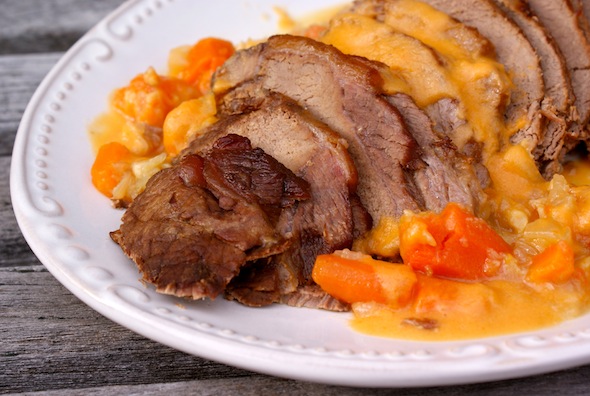Pot roast is a major comfort food. According to the Encyclopedia of American Food and Drink, the term pot roast first appeared in print in 1881. Back then it was described as meat that is browned and cooked with vegetables and gravy in a deep pot or saucepan that is covered. It really has not changed much at all. It is easy to make it appropriate for SCD, GAPS or Paleo/Primal. Just leave out the starchy tubers like potatoes and don’t thicken the gravy with flour. I’ll show you how.
Braised and succulent
Pot roast is a braised beef dish. I never knew what braising was until I looked it up a few years ago. It means that the cooking relies on heat, time, and moisture to break down the tough connective collagen tissues in meat. Simply put, it means cooked in water or some other liquid. This makes braising an ideal way to cook those tougher (cheaper and better for you because they have the collagen tissue in them) cuts. Pot roast is typically made by gently browning a roast-sized piece of beef, then slow-cooking in liquid in a covered dish.
What cuts of meat are used?
Tougher cuts such as boneless chuck roast, bottom round and rump roast are good cuts of beef for this cooking technique. These cuts are tough and fibrous, but they become tender and flavorful after slow braising. The chuck roast comes from just above the shoulder and the rump roast comes from — well you get a sense of where that comes from. The only difference is the location of the fat — in the chuck it is marbled through the meat, the rump has it lying on top.
As with all braises, slow cooking tenderizes the meat and the liquid (water, stock or even a splash of wine) melds its flavor with that of the beef, resulting in falling-off-the-fork-meat that is dripping with tenderness.
If you are using grassfed beef, the best way to cook it is slow and low — for a long time on a low temperature.
Pot roast is often served with carrots and potatoes as well as other vegetables such as onions simmered in the cooking liquid. It’s a very simple fix to keep out the starchy vegetables and make the gravy without flour.
I used to make it in the crockpot, but discovered I love it more when it is cooked low and slow in my dutch oven.
Ingredients
- 2 – 3 pound of chuck or rump roast from a grassfed animal
- 1 large onion peeled and sliced
- 3 – 4 stalks celery sliced (organic if possible — this is high on the list of the dirty dozen)
- 4 – 5 carrots peeled and chopped into bite-sized pieces
- 4 cloves garlic sliced
- Bay leaf
- Sea salt (where to buy salt)
- Peppercorns (10)
- 1 – 2 cups beef stock or bone broth
- 1 – 2 cups water
Equipment
- 5 – 6 quart dutch oven (where to buy a dutch oven)
- knives (where to buy high quality knives)
Instructions for the roast
- On top of the stove, heat the dutch oven to medium, melt some tallow or lard and gently brown all sides of the roast
- Remove the roast from the pot and hold it aside in a large bowl
- There should be plenty of fat in the pan — add all the vegetables except the garlic and saute until somewhat soft
- At the end, for a minute or two, add the garlic and let it warm up
- Add the meat back in on top of the vegetables
- Add the beef stock, the water and the bay leaf and any other herbs you may like
- The liquid should immerse the meat more than half way
- Cover the dutch oven and put inside the stove at 275 degrees F for 3 — 4 hours
- After cooking, remove the pot from the oven
- Take the meat out of the pot, put it on a plate and let rest on the counter
- Slice with an electric knife when it has rested but is still warm (if you let it get cold it is very hard to slice)
Instructions for the gravy
- Remove all the meat from the dutch oven
- Put a strainer over a large pot
- Pour the gravy into the pot through the strainer
- Take about half the vegetables (I usually pick out the pepper corns and the celery and discard them) and put back in the pot
- Using an immersion blender, blend the vegetables with the liquid gravy
- This will thicken the gravy without using any starches or flours and it tastes great
- Put the vegetables that you saved, back into the gravy
- You now have a thick and savory gravy with vegetable pieces (you may want to add salt to the gravy or at the table)
- When refrigerated, this gravy will gel due to all the collagen and gelatin in the stock and the meat
- To reheat just put all the sliced meat in a large pot with the gravy and heat gently on a low temperature












